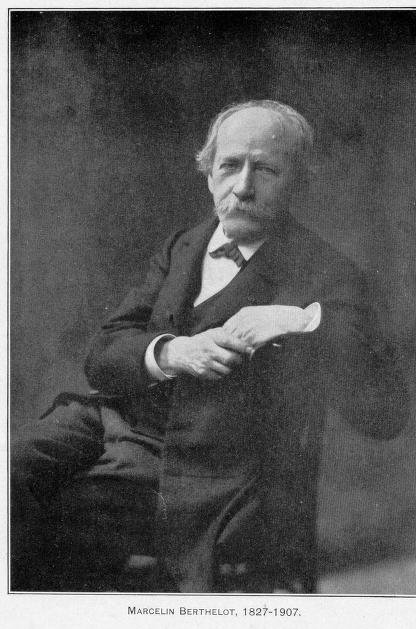<Back to Index>
- Chemist Marcellin Pierre Eugène Berthelot, 1827
- Writer and Secretary of War Thomas Babington Macaulay, 1st Baron Macaulay, 1800
- King of the Romanians Michael, 1921
PAGE SPONSOR



Marcelin Pierre Eugène Berthelot (25 October 1827 – 18 March 1907) was a French chemist and politician noted for the Thomsen - Berthelot principle of thermochemistry. He synthesized many organic compounds from inorganic substances and disproved the theory of vitalism. He is considered as one of the greatest chemists of all time.
He was born in Paris, the son of a doctor. After doing well at school in history and philosophy, he became a scientist. During 1851 he became a member of the staff of the Collège de France as assistant to A.J. Balard, his former master, and about the same time he began his life long friendship with Ernest Renan. In 1854, he made his reputation by his doctoral thesis, Sur les combinaisons de la glycérine avec les acides, which described a series of beautiful researches in continuation and amplification of M.E. Chevreul's classic work. During 1859 he was appointed professor of organic chemistry at the École Supérieure de Pharmacie, and in 1865 he accepted the new chair of organic chemistry, which was specially created for his benefit at the Collège de France. He became a member of the Academy of Medicine during 1863, and ten years afterwards entered the Academy of Sciences, of which he became perpetual secretary in 1889 in succession to Louis Pasteur. In 1870, he was elected a foreign member of the Royal Swedish Academy of Sciences. He was appointed inspector general of higher education in 1876. In 1880, He was elected a Foreign Honorary Member of the American Academy of Arts and Sciences. After his election as life senator in 1881, he continued to take an active interest in educational questions, especially as affected by compulsory military service. In René Goblet's ministry of 1886 – 1887 he was minister of public instruction, and in the Bourgeois cabinet of 1895 – 1896 he held the portfolio for foreign affairs. His scientific jubilee was celebrated in Paris in 1901.
The
fundamental conception that underlay all Berthelot's chemical work was
that all chemical phenomena depend on the action of physical forces
which can be determined and measured. When he began his active career it
was generally believed that, although some instances of the synthetic
production of organic substances had been observed, on the whole organic chemistry remained
an analytical science and could not become a constructive one, because
the formation of the substances with which it deals required the
intervention of vital activity in some shape. To this attitude he offered uncompromising opposition, and by the synthetic production of numerous hydrocarbons, natural fats, sugars and
other bodies he proved that organic compounds can be formed by ordinary
methods of chemical manipulation and obey the same principles as
inorganic substances, thus exhibiting the "creative character in virtue
of which chemistry actually realizes the abstract conceptions of its
theories and classifications — a prerogative so far possessed neither by
the natural nor by the historical sciences."
His investigations on the synthesis of organic compounds were published in numerous papers and books, including Chimie organique fondée sur la synthèse (1860) and Les Carbures d'hydrogène (1901). He stated that chemical phenomena are not governed by any peculiar laws special to themselves, but are explicable in terms of the general laws of mechanics that are in operation throughout the universe; and this view he developed, with the aid of thousands of experiments, in his Mécanique chimique (1878) and his Thermochimie (1897). This branch of study naturally conducted him to the investigation of explosives, and on the theoretical side led to the results published in his work Sur la force de la poudre et des matières explosives (1872), while in practical terms it enabled him to render important services to his country as president of the scientific defence committee during the siege of Paris in 1870 – 71 and subsequently as chief of the French explosives committee. He performed experiments to determine gas pressures during hydrogen explosions using a special chamber fitted with a piston, and were able to distinguish burning of mixtures of hydrogen and oxygen from true explosions.
During later life he researched and wrote books on the early history of chemistry such as Les Origines de l'alchimie (1885) and Introduction à l'étude de la chimie des anciens et du moyen âge (1889). He also translated various old Greek, Syriac and Arabic treatises on alchemy and chemistry: Collection des anciens alchimistes grecs (1887 – 1888) and La Chimie au moyen âge (1893). He was the author of Science et philosophie (1886), which contains a well known letter to Renan on "La Science idéale et la science positive," of La Révolution chimique, Lavoisier (1890), of Science et morale (1897), and of numerous articles in La Grande Encyclopédie, which he helped to establish.
He died suddenly, immediately after the death of his wife Sophie Niaudet (1837 – 1907), at Paris, and was buried with her in the Panthéon. He had six children: Marcel André (1862 – 1939), Marie - Hélène (1863 – 1895), Camille (1864 – 1928), Daniel (1865 – 1927), Philippe (1866 – 1934), and René (1872 – 1960).